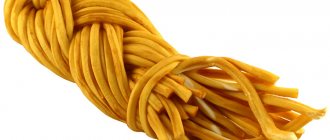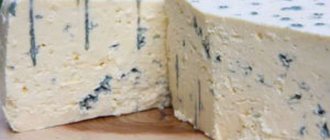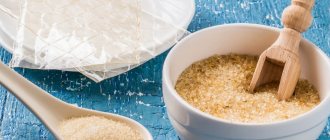Adyghe cheese belongs to the soft group of cheeses. It is made in the foothills or mountainous regions of the Caucasus. What is it made of? Made from pasteurized cow's milk that is heated to 95°C, which is why this cheese is primarily white in color.
The chemical composition of Adyghe cheese is a whole series of vitamins A, B, as well as groups H and PP. The cheese contains calcium, which makes it good for bones and teeth. Adyghe cheese is a storehouse of minerals and trace elements. It is also rich in enzymes, amino acids, proteins and other beneficial substances.
What are the benefits of Adyghe cheese?
Adyghe cheese is an extremely healthy dish. It has a positive effect on the human digestive system. Vitamins from group B, as well as minerals, are beneficial for the nervous system. Nutritionists do not prohibit people who are overweight or are on a diet from including such cheese in their diet. Adyghe cheese has no restrictions for use by hypertensive patients and is not prohibited for pancreatitis. Due to the fact that it is quickly digested by the body, it is useful for athletes, as well as for people weakened by illness. Adyghe cheese is not prohibited for mothers who are breastfeeding if they do not have high blood pressure, urolithiasis, or gastrointestinal diseases.
In a word, this cheese contains all the valuable substances that are so necessary for a person to be healthy.
Tips for choosing
To buy a quality product, you need to know how to choose it. In this regard, there are useful recommendations:
- The color of the cheese is important - the ideal option is white or a white-yellowish tint, sort of creamy;
- As for the consistency, it should be soft and look greasy. It may crumble a little when you touch it. A crust on its surface is unacceptable, no matter what the sellers say. The product should not be dry or very hard; if it is, it means it was not prepared properly. In Adygea they know this well;
- the taste should feel soft and tender, with a slight saltiness, something like whey. There should be no strong odors or strong taste, this is evidence of long storage.
It is important to pay attention to the shelf life of the product; it is not long, a week at most. If the packaging says it was made several weeks ago, it means it contains preservatives. It should be noted that cheese products are beneficial for the body only when they are natural.
Adyghe cheese for weight loss
Adyghe cheese is ideal if you want to lose weight, but at the same time you find it difficult to give up dairy products. Due to the fact that it is soft, it can be added to a salad or eaten with bread. It’s also just right to slice it with fruits or berries, and it will be not only a tasty, but also a healthy dessert. A lot of useful substances contained in Adyghe cheese will help you lose weight.
Let's give an example of dietary fat and calories per 100 grams of product:
- Calorie content – 240 kcal;
- Proteins – 18.5 g;
- fats – 14 g;
- carbohydrates – 0.
Smoked Adyghe cheese has a calorie content of 267.22 kcal per 100 g.
Calorie content of Adyghe cheese, benefits and harms, recipes from it
Adyghe cheese has found wide use in cooking, it is included in dozens of recipes for preparing national cuisine, pies are baked with it, it is added to minced meat, cooked fish and penne, included in salads, it is used when baking eggplants, tomatoes, and other products.
To get the perfect taste of your dishes, you need to take note that Adyghe cheese can be combined with the following products:
- dairy and fermented milk
- duck, chicken, turkey meat
- pasta
- vegetables and herbs, including potatoes
- citrus
- other fruits: pears, grapes, cherries
- nuts and mushrooms
- most types of sea fish
Any housewife or woman who cares about her health tries to choose exclusively high-quality and original products for her diet menu. Some of the fairer sex pursue the goal of losing extra pounds, while others simply want to treat themselves or please their loved ones with something unusual.
Although it may be too expensive to regularly buy original or rare food products for our area today, some of them, while remaining high quality, have an affordable price for most users.
One of the varieties of such popular products is Adyghe cheese, which is valued for its tenderness and a huge amount of useful elements and substances.
Adyghe cheese is used not only for preparing regular dishes for the table, but also for children's and diet food.
Many women wonder how healthy or harmful Adyghe cheese is? Is it high in calories and how much? What kind of dishes can be prepared with this ingredient?
Exploring the quality properties of Adyghe cheese, many women were convinced that the product is indispensable for a low-carbohydrate diet, and can also abundantly saturate the body with healthy proteins and balance fat metabolism.
Adyghe cheese is rich in such a huge amount of useful substances and vitamins that it is recommended by doctors for various pathologies, diseases and other problems, especially those related to the functioning of the gastrointestinal tract or other internal organs.
Among the main beneficial substances that Adyghe cheese contains are:
- Calcium;
- Sulfur;
- Sodium;
- Zinc;
- Phosphorus;
- Vitamins of groups A, B, D and PP.
The presence of such a large amount of vitamins and nutrients allows the use of Adyghe cheese in the diet of children of preschool and school age, as well as people with bone diseases.
On the other hand, supporters of a realistic view of various food products argue that Adyghe cheese is not an ideal product.
Too much saturated fat contained in cheese can accelerate the process of obesity, which has a detrimental effect on the entire human body.
Another important factor that is of particular interest to many women is the calorie content of Adyghe cheese. In a nutshell, 100 g of product contains 264 kcal, which is a percentage of 12.76% of the recommended daily intake of kilocalories.
"Sabji"
At its core, this dish resembles an ordinary vegetable stew, but a whole bunch of spices and seasonings are added to it. This dish can be prepared both in the oven and in a slow cooker. To prepare sabja, the housewife will need the following ingredients:
- Potatoes – 400 g;
- White cabbage – 300 g;
- Carrots – 1 piece;
- Onions – 1 piece;
- Garlic – 3 cloves;
- Adyghe cheese – 100 g;
- Tomato – 1 glass;
- Olive oil – 4 tbsp. l.
Cooking method:
- All ingredients are washed, peeled and cut into cubes, and the garlic is chopped;
- Garlic and onions are fried in heated olive oil until they become soft, after which all kinds of spices are added;
- After this, carrots are placed in the frying pan, which are fried for 5 minutes, and then Adyghe cheese, also cut into cubes, is added;
- The potatoes are fried for 5 minutes, then the cabbage is also fried;
- In the “Stew” multicooker mode, add tomato and salt to the container with the remaining ingredients and cook until the end of the device program.
Read more: Why children take omega 3 fatty acids
"Gauranga"
Translated from Indian, this dish means “golden potatoes”. Ingredients required for its preparation:
- Potatoes – 1 kg;
- Sour cream – 300 g;
- Adyghe cheese – 350 g;
- Turmeric – 1 tsp;
- Greens – 1 bunch;
- Garlic – 2 cloves;
- Salt;
- Pepper;
- Vegetable oil – 1 tbsp. l.
Technology for preparing the original dish:
- Potatoes are cut into thin slices;
- Add turmeric to sour cream and mix thoroughly until it turns yellow;
- Grease a baking sheet with oil and place 1/3 of the potatoes in it, then salt and pepper to taste;
- The potatoes are sprinkled with chopped garlic and chopped herbs, and the top is coated with sour cream and sprinkled with grated Adyghe cheese;
- The remaining 2/3 of the potatoes are placed on top, according to the principle of the first layer;
- The baking sheet is placed in the oven and baked at temperatures up to 200 degrees for 45 minutes.
Adyghe cheese has become not only a favorite for many women, but also a constant ingredient in many dishes.
https://www.youtube.com/watch?v=izscloWnR3M
The secret of cooking came to us from Adygea, where it got its name. It differs from others in the brine method of preparation.
For this, different types of whole milk are used: sheep, cow or goat. According to the official classification, it belongs to soft varieties without ripening.
It has a soft, delicate taste, unlike anything else, which is why it has gained its popularity and is a favorite product on the table. Let's figure out whether Adyghe cheese is healthy?
The secret of cooking came to us from Adygea, where it got its name. It differs from other varieties in the brine method of preparation.
For this, different types of whole milk are used: sheep, cow or goat. According to the official classification, it belongs to soft varieties without ripening.
It has a soft, delicate taste, unlike anything else, for which it gained its popularity and became an integral part of any table. Let's figure out whether Adyghe cheese is healthy?
KBJU per serving - 323 kcal/31.2 g/16.7 g/4.2 g
Ingredients:
- Adyghe cheese - 150 g;
- canned tuna without oil - 1 can;
- cherry tomatoes - 250 g;
- pesto - 1 tbsp;
- ground black pepper, garlic - to taste.
Place tuna without liquid in a salad bowl, add pesto with pepper and garlic and mix. Add finely chopped cubes of Adyghe cheese and cherry halves to the bowl, mix.
KBJU per serving: 156 kcal/26.7 g/3.4 g/5 g
Ingredients:
- soy sauce - 50 ml;
- chicken breast - 370 g;
- fresh champignons – 190 g:
- onions - 1 pc.;
- Adyghe cheese - to taste;
- olive oil - 1 tbsp;
- spices - to taste.
Marinate a chicken breast cut lengthwise in soy sauce and your favorite spices for half an hour or (if you have time) an hour. Fry finely chopped onion in oil. Add chopped mushrooms and spices to it and simmer for 10 minutes under the lid. Cook until the liquid evaporates. Form chicken rolls by stuffing the breast with the resulting mixture and adding a few pieces of Adyghe cheese, and secure with toothpicks. Bake without oil on foil for 25 minutes.
Cooking method
Bring the milk to a boil over low heat, then add kefir to it. Next, stir the resulting mixture over low heat until the milk curdles. When individual pieces of cheese appear on the surface, turn off the stove. Pass the resulting mixture through a sieve. Put the whey in the refrigerator, and put the cheese under a press and leave it for a day. Make sure that the room where the cheese is located is not too hot or too cold. A day later, remove the whey from the refrigerator, salt it (3 tablespoons per 1 liter of salt), dipping the cheese in it for a couple of days.
Adyghe cheese in a slow cooker
Ingredients:
- sour milk – 1 l;
- chicken egg – 1 pc.;
- salt – 5 g.
Beat a raw egg with salt in a deep bowl and pour into milk. Next, pour the resulting mixture into the multicooker bowl and cook for 20 minutes in the “Baking” program. During this time, the whey will separate from the milk. We strain it through a sieve and leave it under pressure for a couple of hours.
Preparation
Put the milk to boil, and at this time, in a separate container, mix sour cream, salt and eggs. Then finely chop the greens. After the milk boils, reduce the heat on the burner and gradually pour the prepared mixture into the milk, stirring it. Let the milk remain on the heat until you see the whey separating. Then add herbs, salt and cumin. Pour the milk into a pre-prepared sieve lined with two layers of gauze. Then place the prepared cheese in a bowl under a press. Leave the cheese under pressure for 1 hour, then transfer the container with the cheese to the refrigerator. Leave the press as desired. And after just 4 hours, try homemade cheese and herbs!
You can make Adyghe cheese from goat's milk if you prefer it over cow's milk.
The product is ready and the question arises: how to store Adyghe cheese and is it possible to freeze Adyghe cheese?
Two days is the longest shelf life of Adyghe cheese. It is placed in the refrigerator in a bag that does not allow moisture and odors to pass through. This will increase its shelf life, but it is recommended to make a new batch of cheese each time. There is no need to freeze Adyghe cheese, since after defrosting the cheese does not taste the same at all, and it can only be used for baking.
Why is Adyghe cheese bitter?
Properly prepared Adyghe cheese will not taste bitter - this is the prerogative of strongly fermented cheeses, which otherwise undergo a fermentation process.
Since Circassian cheese is made from fresh pasteurized milk, is not pressed and is not stored for more than 2 weeks, there can be no bitterness. An exception may be cheese made from goat or sheep milk, which in itself has a specific taste, especially when it comes to mountainous areas where herbs rich in essential oils grow. In such cases, bitterness is not a problem. The same flavor profile is often found in feta cheese.
However, if Adyghe cow cheese is bitter, most likely it contains unfriendly bacteria or fungi, and it is better to throw away such a product or at least thoroughly heat-treat it. It’s better to fry this cheese in a frying pan, and not just put it on dumplings or pancakes.
To distinguish bad bitterness, it is enough to rely on your experience: such a tint usually accompanies the bad taste of old milk, a smeary consistency that is abnormal for cottage cheese, sharpness like peroxided kefir, and similar signs. The taste may be similar to rancid butter, which occurs when unfermented egg whites curdle.
Bitterness can appear if the preparation technology is violated, when the milk is not warmed up enough, too little whey (another acid), salt is added, or it is not sent to the cold on time. Peroxided cheese should be thrown away to avoid food poisoning.








